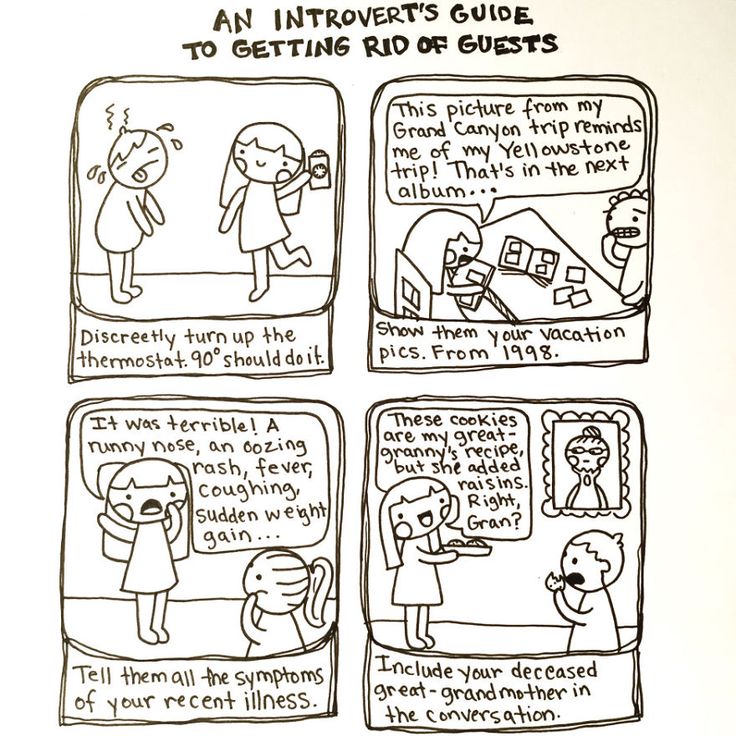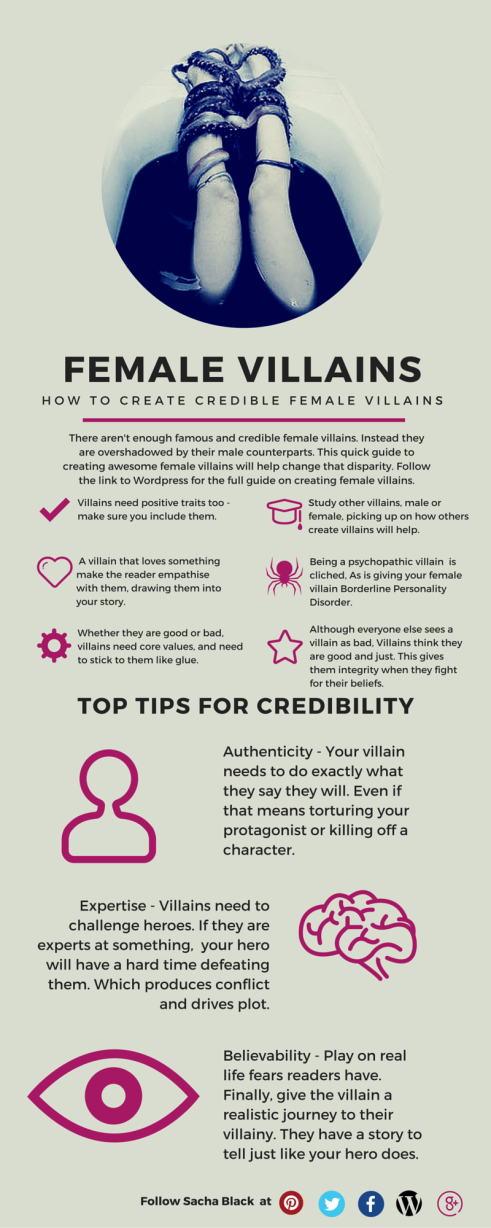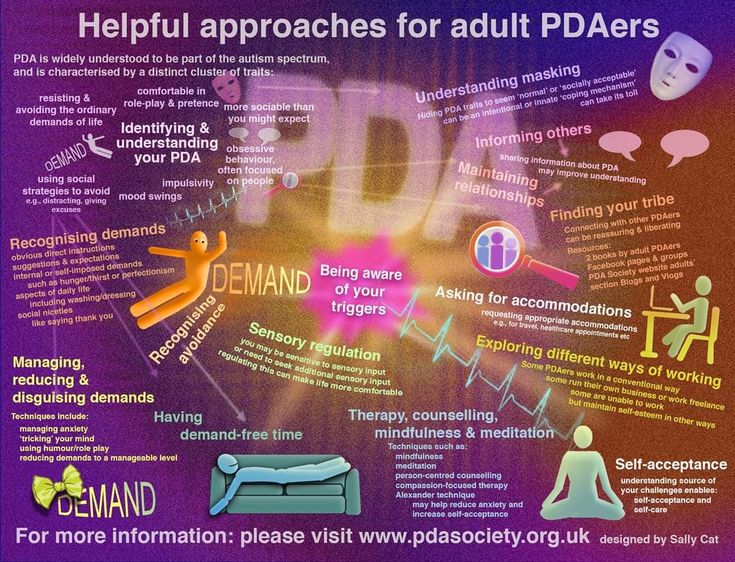Best meditation for anxiety
The Last Meditation for Anxiety You’ll Ever Need
Which comes first? Stress or anxiety? Without stress, anxiety doesn’t have a chance to take hold of you. And without intervention anxiety will keep adding stress to your life and stress will continue to feed anxiety.
How do we break this vicious cycle of stress and anxiety? Meditation!
If you are afraid you cannot meditate, don’t worry. We have easy guided meditations for you. Plus, the last meditation technique for stress and anxiety you’ll ever need!
What’s the difference between stress and anxiety?
To better understand the relationship between stress and anxiety, let’s define each.
Stress is the feeling of being overwhelmed or unable to cope with mental or emotional pressure. When we feel stressed our body produces stress hormones that trigger the flight or fight response.
Basically, as far as our body is concerned we have to run away from the stressful situation or we need to put up our dukes and fight for our life. Although helpful in a life-threatening situation, this is no way to live. And it’s both physically and emotionally exhausting.
Anxiety is a feeling of worry, nervousness, or unease, typically about an imminent event or something with an uncertain outcome.
It’s easy to see that repeated stress leads to anxiety.
Since we cannot avoid stress completely, we need a powerful, effective tool to help manage both.
Generalized Anxiety Disorder and Meditation
When it comes to generalized anxiety disorder, meditation can be a big help. What is generalized anxiety disorder (GAD)? GAD is marked by excessive, exaggerated anxiety and worry about everyday life events for no obvious reason.
Anxiety disorders like GAD take a massive toll on mental health and the ability to live a meaningful life. Clearly, stress unchecked can have profound negative impacts on our well-being.
Mindfulness-based stress reduction (MSBR) is a fairly popular technique for dealing with stress and anxiety issues.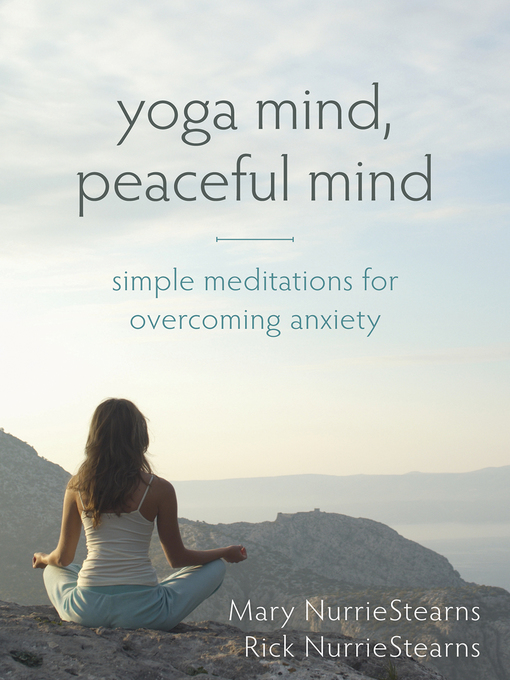 A technique you may not have heard of yet, SKY Breath Meditation, definitively outperformed MBSR in a Yale study. Following the SKY sessions, students reported improvements in six areas of well-being: depression, stress, mental health, mindfulness, positive affect, and social connectedness. While MBSR, which relies heavily on mindfulness techniques, resulted in no reported improvements.
A technique you may not have heard of yet, SKY Breath Meditation, definitively outperformed MBSR in a Yale study. Following the SKY sessions, students reported improvements in six areas of well-being: depression, stress, mental health, mindfulness, positive affect, and social connectedness. While MBSR, which relies heavily on mindfulness techniques, resulted in no reported improvements.
Meditation for anxiety and stress relief
Meditation helps with both stress and anxiety. And it’s easy to use! I promise!
Here are the 3 best meditation programs for managing stress and anxiety:
Guided meditation. This is probably one of the most well-known methods. Temporary relief happens in mere minutes. We have included four guided meditations throughout this post for you to get started.
Mantra meditation.
 Sahaj Samadhi Meditation is an effortless meditation practice that you use for 20 minutes twice a day. Relief is usually gradual with long-term benefits.
Sahaj Samadhi Meditation is an effortless meditation practice that you use for 20 minutes twice a day. Relief is usually gradual with long-term benefits.Breath-based meditation. SKY Breath Meditation has helped millions of people find their calm by breathing in specific patterns for just 10 minutes a day. Participants report immediate benefits that are also experienced long-term.
Practicing meditation is easy peasy (sorta)
I promised that meditation is easy to use for stress and anxiety relief. And it is. But there is a catch, as well very specific instructions on how to meditate that you will need to know.
First, the catch so to speak. You have to practice meditation daily. You cannot poke it with a stick one day and not the next. Imagine a ferocious tiger that is ready to pounce on you. If you poke it with a big stick like meditation the tiger backs off.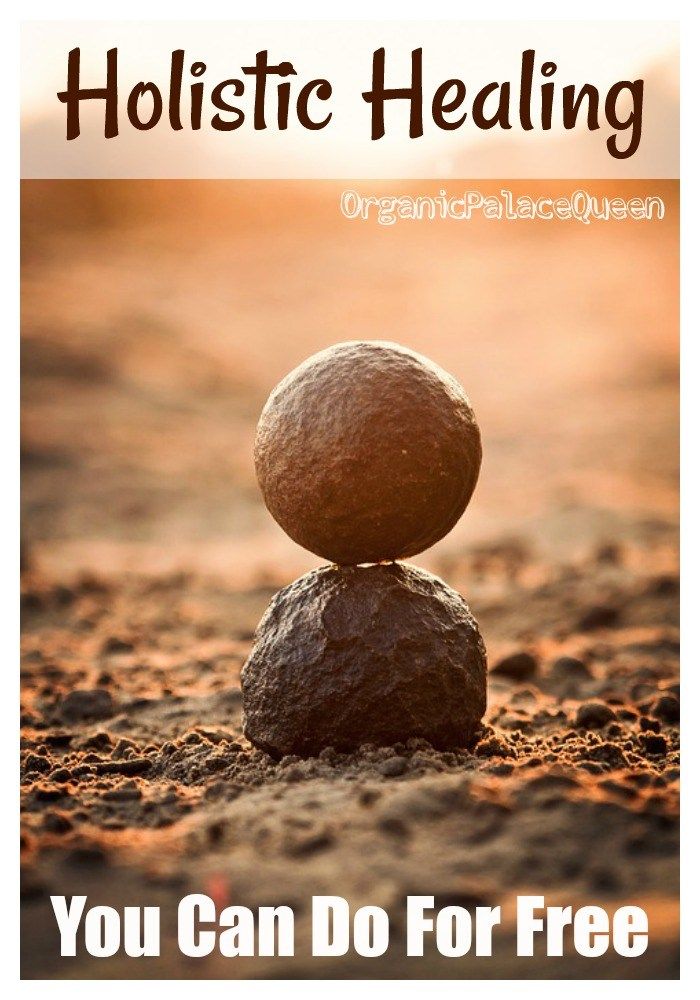 But if you put the stick down, the tiger will come after you. That tiger will eat you alive unless your stick is a meditation practice you do every day.
But if you put the stick down, the tiger will come after you. That tiger will eat you alive unless your stick is a meditation practice you do every day.
Now for the how-to meditate instructions. There are a lot of misconceptions surrounding meditation. The biggest misconception is that you should use a lot of effort to try to get rid of thoughts. This will not only keep you from a relaxing meditation session but it will likely add to your anxiety! Why? Because you cannot get rid of thoughts by trying not to think. It’s a simple law of the mind— what you resist, persists.
Don’t worry about your mind wandering. Breathing exercises done right before your meditation will help with quieting the mind so your thoughts are not so bothersome.
Tip for how to stop panic attacks
Obviously preventing a panic attack is preferable, and is possible with a daily routine of meditation. But what can you do if anxiety triggers a panic attack? BREATHE. Try a few moments of deep breaths. Breath can make all the difference simply because breath is in the present moment. While anxiety is about worry and what will happen in the future.
Try a few moments of deep breaths. Breath can make all the difference simply because breath is in the present moment. While anxiety is about worry and what will happen in the future.
You can also read about a 5-minute meditation using breath awareness here.
If you think you have a panic disorder, please seek treatment from your health care professional.
Guided meditation to stop overthinking
Are anxious thoughts bombarding your mind? Here’s a guided meditation by Art of Living founder and meditation master, Gurudev Sri Sri Ravi Shankar. Sri Sri helps you stop overthinking and start enjoying inner peace in less than 30 minutes.
Take time for yourself, hit the play button, pause all those thoughts and experience a deep state of relaxation!
Remedy negative emotions
If negative emotions and negative thoughts are getting the best of you, try this daily meditation for positivity led by Sri Sri. This 22-minute meditation will make a difference in your everyday life.
Mindfulness meditation for anxiety
Sit back and relax as Sri Sri guides you through this easy 10-minute mindfulness-based stress reduction meditation resulting in more mindfulness and less anxiety.
Reduce anxiety with meditation for acceptance
Since anxiety has a lot to do with worrying about what might or might not happen in the near or far future, acceptance can help us feel less anxious. Sri Sri leads this guided meditation for acceptance. And it’s only 6 minutes, try it out!
Anxiety and depression association
When anxiety continues over a period of time and gets too deep into you, worries about the future become more and more around the idea of “What will happen to me?” This kind of worrying leads to depression. But even depression can be overcome with meditation.
From anxiety to relief— a healing journey with SKY Breath Meditation
Check out this impressive testimonial of a SKY Breath Meditation practitioner’s healing journey.
Long-term anxiety relief is possible with SKY Breath Meditation. SKY reduces serum cortisol levels (a stress hormone) by as much as 78%! SKY also significantly reduces anxiety and depression. SKY even helps with PTSD.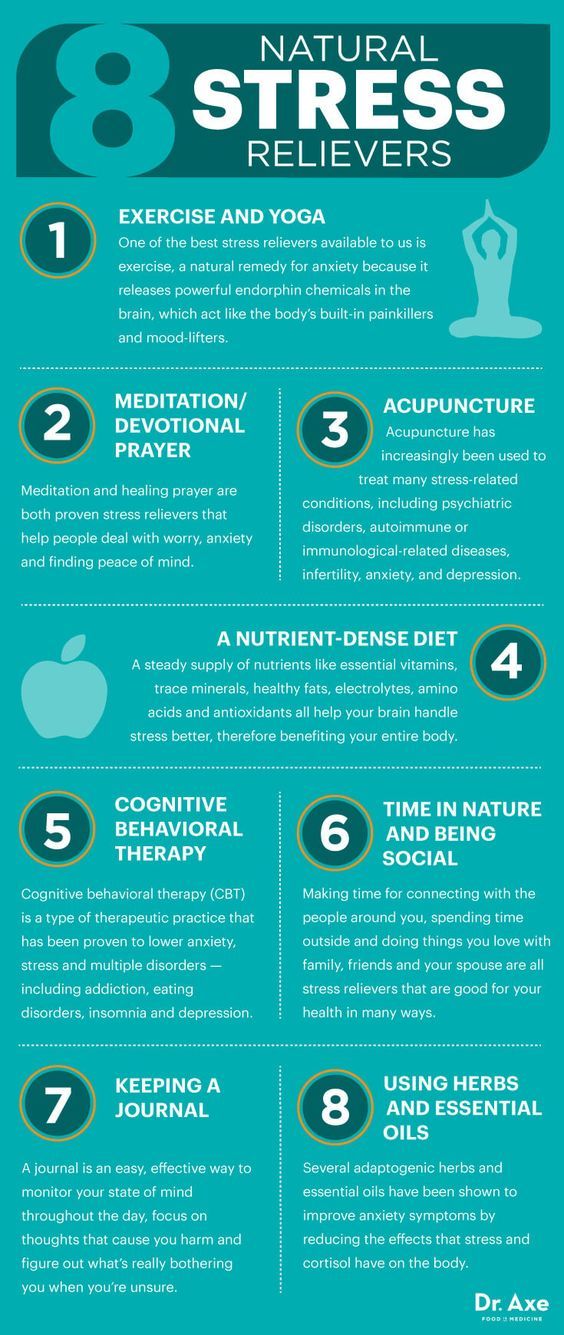
SKY Breath Meditation is quite possibly the last meditation technique you will ever need! Millions worldwide think so!
You can learn more about SKY Breath Meditation by attending a free breath and meditation online session. Just click on the image below to choose your day and time and start your journey to inner peace now.
Which Type of Meditation Is Best for Anxiety?
This is an interesting and somewhat complex question. To some degree, any form of meditation may provide some assistance, and in most cases, any meditation is better than no meditation. However, because of the specific way that different meditation practices impact the brain, mindfulness may be your best bet to counteract the impact of chronic stress and anxiety.
Before we go further, let me say a few words about what I mean by mindfulness.
For the purposes of this post, I will use Jon Kabat-Zinn’s definition, which basically describes mindfulness as “paying attention in a particular way, on purpose, in the present moment, and without judgment.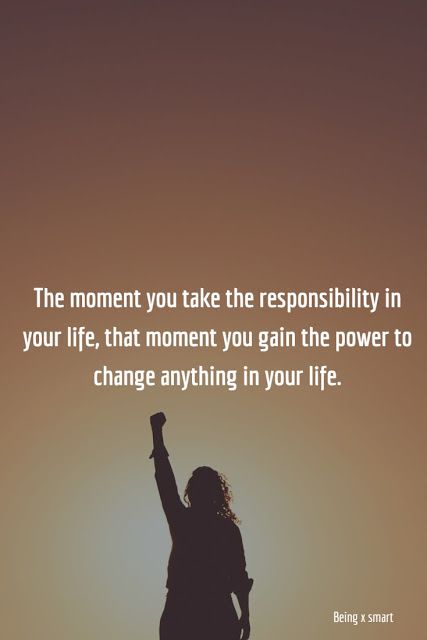 ” (Kabat-Zinn, 2005) This is important, as it separates these practices from other common forms of meditation, including styles that emphasize focus or concentration, loving-kindness or compassion, or expanded consciousness.
” (Kabat-Zinn, 2005) This is important, as it separates these practices from other common forms of meditation, including styles that emphasize focus or concentration, loving-kindness or compassion, or expanded consciousness.
When mindfulness is practiced in line with the definition used above, a few interesting things happen in the brain. First, theta brainwaves increase in a specific portion of the frontal lobe called the Anterior Cingulate Cortex (ACC). Theta waves in this region of the brain are associated with relaxed, gentle attention. This is the kind of attention that is engaged when you observe what is happening in the present moment, yet are not attached to any of it.
Importantly, this is the exact opposite of the brainwaves seen in this region during stress and anxiety (Shapiro, Jr., 2008; West, 1987). When the brain is fixated on something disturbing, the ACC becomes overactivated, increasing beta and high beta brainwaves. When this happens, a person is unable to shift gears.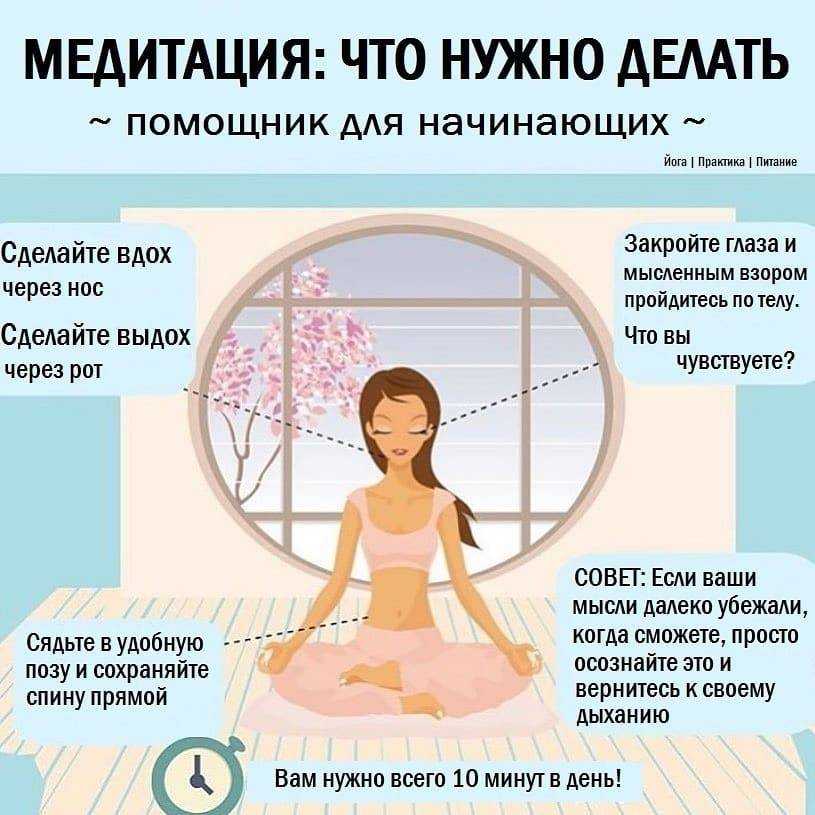 They become stuck on certain thoughts, feelings, and bodily sensations, which can generate or exacerbate feelings of anxiety.
They become stuck on certain thoughts, feelings, and bodily sensations, which can generate or exacerbate feelings of anxiety.
The other part of the brain that appears to be directly impacted by mindfulness practices is the Posterior Cingulate Cortex, or PCC (Garrison, K., et al. 2013). The PCC is the hub of the Default Mode Network and is very much involved in self-referential mental tasks. If you are thinking about yourself or something that relates to your identity, the PCC is going to be engaged.
It is a small leap to see that overactivation of the PCC could also be connected to stress and anxiety. If you are stressed, what is it about? You! If you are anxious, it is generally a result of preoccupation with your beliefs or fears about the future or how things will affect you and your family and friends. Mindfulness practice allows us to shift into more of an observer role, gaining perspective, and unhooking from the tendency to experience everything as personal.
So, in a very tangible way, mindfulness practices provide a counter-balance to anxiety patterns in the brain (Tarrant, 2017). In future posts, we will explore specific mindfulness strategies, trauma-informed meditation practices, and meditation for other mental health concerns.
In future posts, we will explore specific mindfulness strategies, trauma-informed meditation practices, and meditation for other mental health concerns.
References
Garrison, K., et al. (2013). Effortless Awareness: using real time neurofeedback to investigate correlates of posterior cingulate cortex activity in meditators’ self-report. Frontiers in Human Neuroscience, 7: 440. doi: 10.3389/fnhum.2013.00440
Kabat-Zinn, J. (2005). Wherever you go, there you are: Mindfulness meditation in everyday life (10th ed.). New York, NY: Hachette Books.
Shapiro, Jr., D.H. (2008). Meditation: Self-regulation strategy and altered state of consciousness. Piscataway, NJ: Aldine Transaction.
Tarrant, J. (2017). Meditation interventions to rewire the brain: Integrating neuroscience strategies for ADHD, anxiety, depression, & PTSD. Eau Claire, WI, PESI Publishing.
West, M. (1987). The psychology of meditation. New York, NY: Clarendon Press/Oxford University Press.
how it can help you
According to the National Institute of Mental Health, approximately 19 percent of the population suffers from anxiety disorders.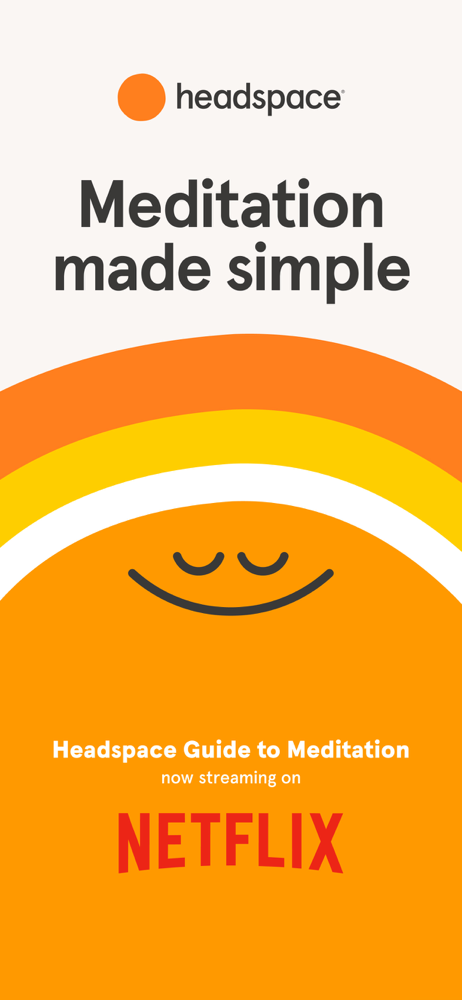 However, others struggle daily with generalized anxiety and excessive stress.
However, others struggle daily with generalized anxiety and excessive stress.
How can guided meditation help you? Anxiety can be pervasive, affecting every area of your life, from romantic relationships and friendships to work and home life. nine0003
If left untreated, stress can even cause physical symptoms, often affecting cardiovascular health in the first place. Since cardiovascular disease is "the leading cause of death for men and women," it is essential that something be done to combat any cause of cardiovascular stress, if not through meditation, then through the health system.
Login: Meditation - specifically guided meditation, a type of meditation led by another person, preferably a trained and experienced instructor, to help you achieve mindfulness and relaxation based on stress reduction. nine0003
Can guided meditation help with anxiety?
Definitely. In fact, one of the main reasons to start any meditation practice is to reduce stress and anxiety in your life.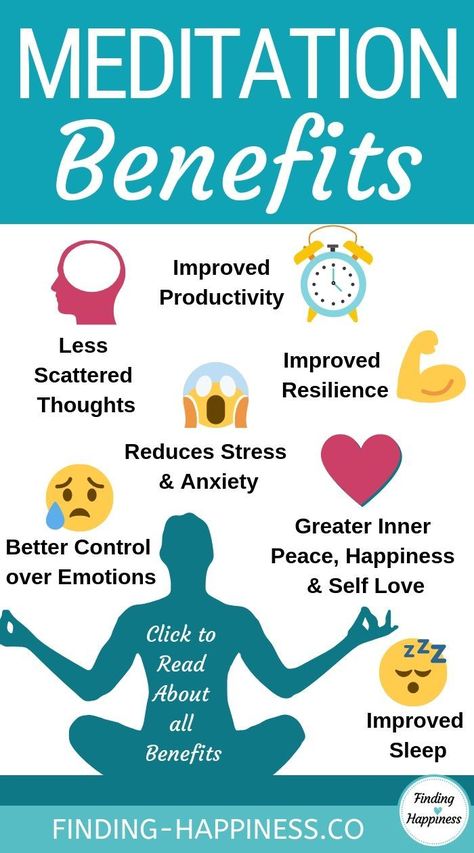 These are just some of the benefits of meditation. Guided meditation is the perfect place to start, as it places the responsibility of organizing and planning a meditation session on the person who has learned and practices the method.
These are just some of the benefits of meditation. Guided meditation is the perfect place to start, as it places the responsibility of organizing and planning a meditation session on the person who has learned and practices the method.
However, before moving on, let's give a general definition of anxiety. nine0003
What is anxiety?
We all have moments of extreme stress when our worries and fears seem to take over. It can be defined as anxiety, "an emotion characterized by feelings of tension, anxious thoughts, and physical changes such as increased blood pressure." Anxiety disorders, on the other hand, are more chronic. In an anxiety disorder, the anxiety attacks you experience are intense and constant. You may experience anxiety about everyday events that don't normally cause stress to other people. For example, a person with an anxiety disorder may experience anxiety leaving the house to get mail or having a short face-to-face interaction with someone at the grocery store.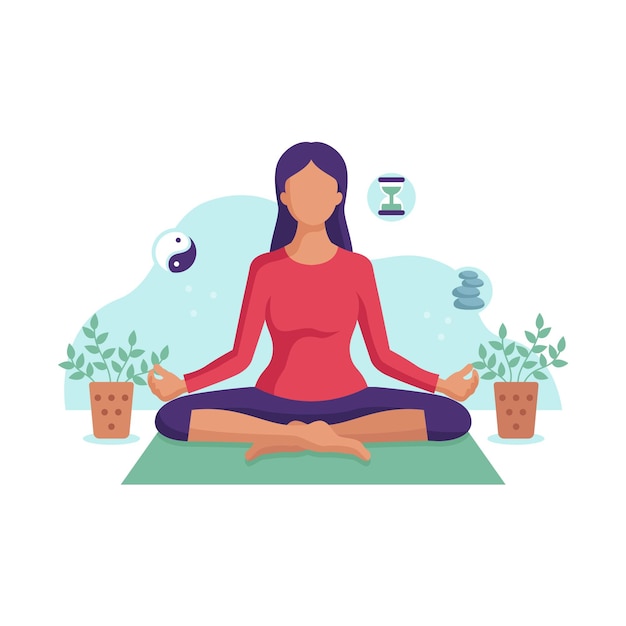 nine0003
nine0003
There are several types of anxiety disorders, including generalized anxiety disorder, panic disorder, agoraphobia, separation anxiety disorder, and social anxiety disorder.
Symptoms associated with anxiety and anxiety disorders include:
-
Feeling of immediate panic and/or despair
-
Sweating
-
Feeling very tired or weak
nine0035 -
Increased heart rate
-
Sleep difficulties
-
Gastrointestinal symptoms
-
An extreme desire to avoid any physical sensation that causes undue anxiety, stress or anxiety
-
Difficulty controlling feelings of avoidance and stress
-
Tension headaches
-
High blood pressure
Awe
What is guided meditation?
Before we define guided meditation, let's define meditation.
What is meditation?
Meditation is a practice that aims to train the mind, ultimately creating increased levels of calmness, focus, spiritual enlightenment and awareness.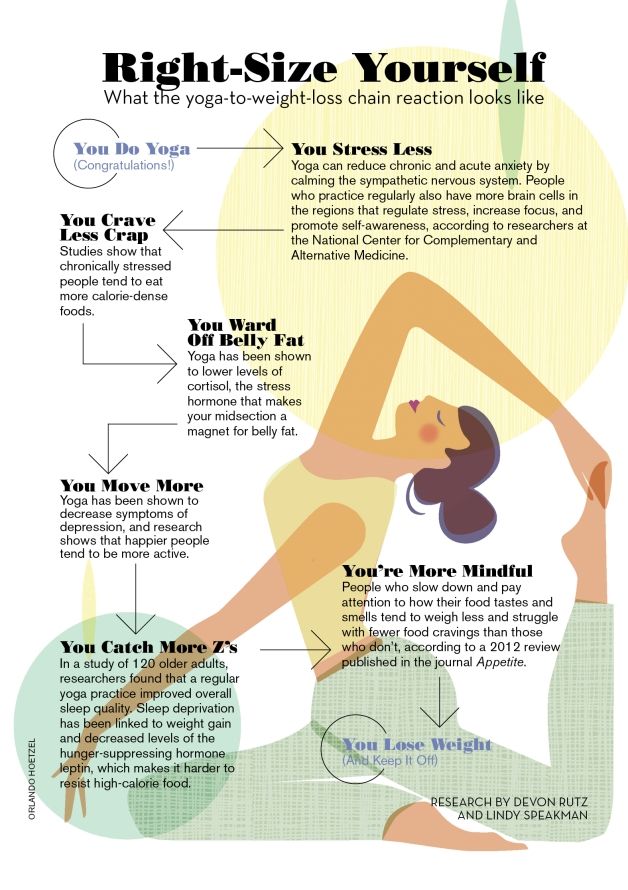 The practice of meditation has its origins in the Buddhist religion, but today it is practiced in many religions as well as in secular life. You don't have to be affiliated with Buddhism or any other religion to practice meditation. nine0003
The practice of meditation has its origins in the Buddhist religion, but today it is practiced in many religions as well as in secular life. You don't have to be affiliated with Buddhism or any other religion to practice meditation. nine0003
Formally, meditation usually involves sitting in a still position (often cross-legged or kneeling on a meditation cushion) and focusing the mind on the breath or on a particular thought or visualization. Each meditation session lasts a certain amount of time. Monks who meditate for most of their day can meditate for hours. For other practitioners, the meditation usually lasts from five minutes to half an hour.
What is guided meditation? nine0007
Guided meditation differs from other types of meditation only in that it is led by an experienced instructor. In other words, in some traditional meditation methods, practitioners simply sit in silence for a certain period of time. The teacher can only give instructions at the beginning and at the end of the session.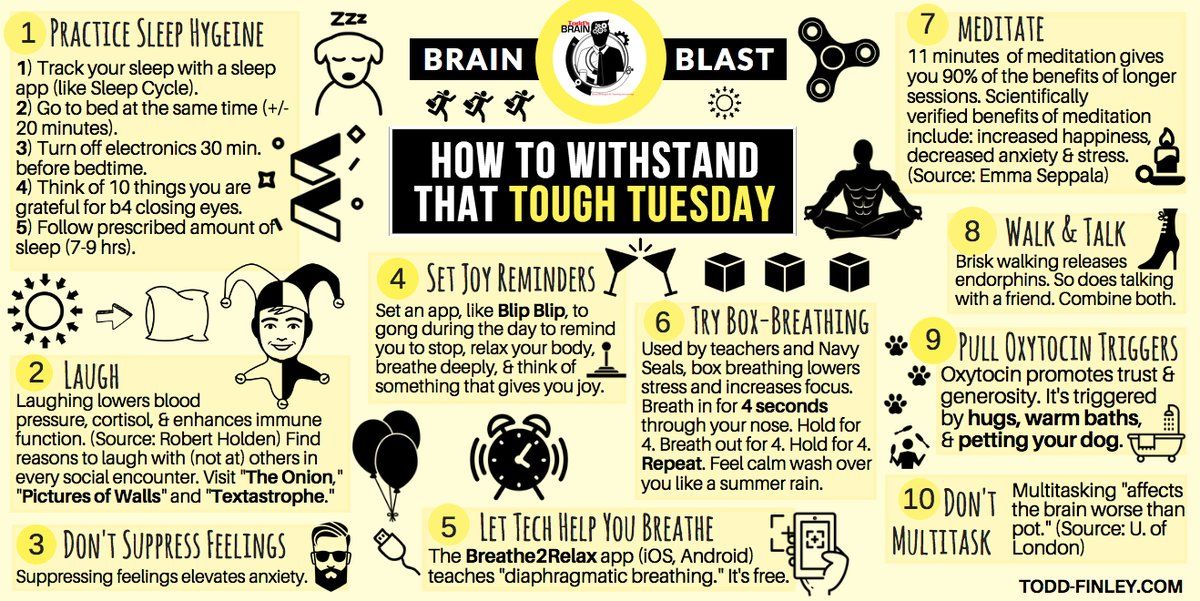 But in the case of guided meditation, the instructor will guide the individual or group by pointing out the steps to be taken throughout the meditation.
But in the case of guided meditation, the instructor will guide the individual or group by pointing out the steps to be taken throughout the meditation.
A meditation instructor might, for example, tell his students how to sit, how to adjust their eyes, how to breathe, and what to think or visualize throughout the session. At the end of the class, he will lead his students out of meditation. nine0003
Guided meditations, especially those taught by Anahana meditation instructors at home, are great for beginners who may need help getting started in their own practice. Guided meditation can be done in a group or class, or one-on-one with a teacher. If a teacher is not available, a recorded meditation text can sometimes be used. The benefits of mindfulness meditation are endless!
How does guided meditation help with anxiety? nine0007
Guided meditation helps meditation in many ways. Here are just four of the anxiety-reducing benefits you can expect from guided meditation:
This will help you focus on the present moment.
Concentration on the present is something that should not be done during meditation. This is the unchanging goal of all meditation - not to dwell on the past or the future, but to focus on the present moment. After all, this is the only moment that you really own. nine0003
This is called the practice of mindfulness or mindfulness.
Of course, mindfulness practice helps reduce anxiety, because most anxiety comes from worrying about the past or worrying about the future. For example, you might be worried about a fight with your partner that happened in the morning, or you might be worried about a presentation that you have to give at the end of the day.
We all know that worry doesn't change anything and can even be harmful. Therefore, improving your focus on the present moment helps dissipate anxiety, making you less stressed, less anxious, and with more inner peace. nine0003
It helps you breathe better.
Guided meditation includes deep breathing as a standard feature.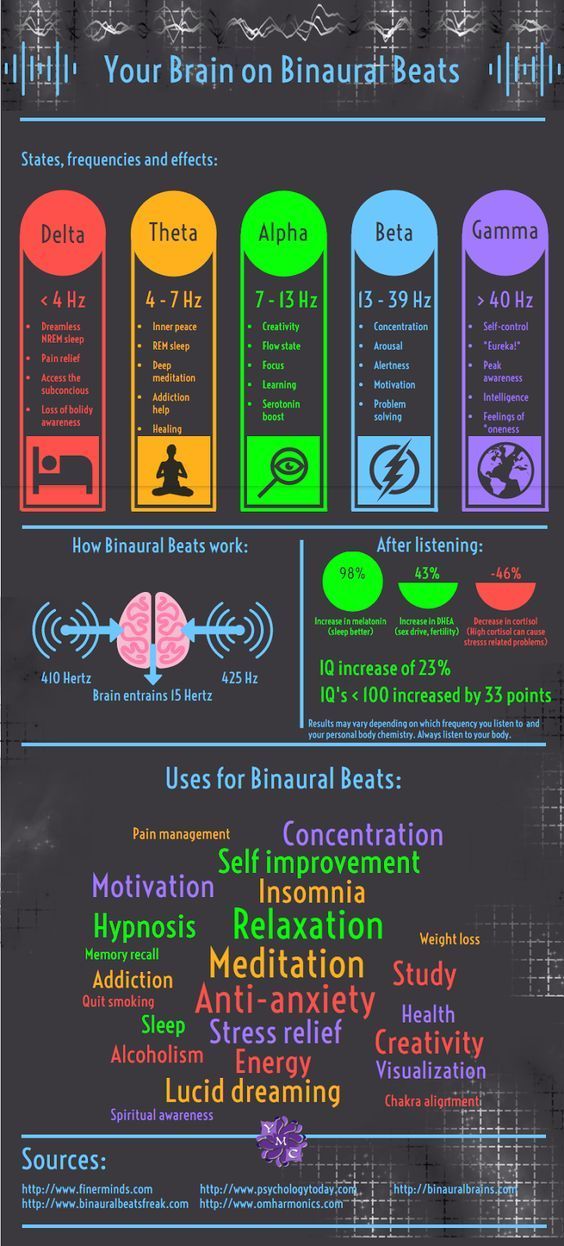 In fact, slow, even, deep breathing is the hallmark of almost all types of meditation. This is one of the reasons why meditation is so helpful in combating anxiety, depression and other mental disorders.
In fact, slow, even, deep breathing is the hallmark of almost all types of meditation. This is one of the reasons why meditation is so helpful in combating anxiety, depression and other mental disorders.
And yet, believe it or not, most people breathe incorrectly. From shallow, short breaths to "shoulder" breathing (not drawing air from the bottom of our lungs), most of us tend to make the same "breathing mistakes" that we've been doing for years without even realizing it. nine0003
The good news is that you can start practicing "Better Breathing" at any time, and guided meditation is a great way to do that. Breathing exercises and deep breathing meditations can transform your life in ways you cannot imagine, especially when practiced along with other mental and physical exercises such as yoga and mindfulness.
Helps you sleep better.
Worry breeds bad sleep, which breeds more anxiety, which breeds bad sleep... and so on and so forth. nine0003
Every person should aim to improve their sleep, as it is known to be a remedy for many mental stresses and physical illnesses.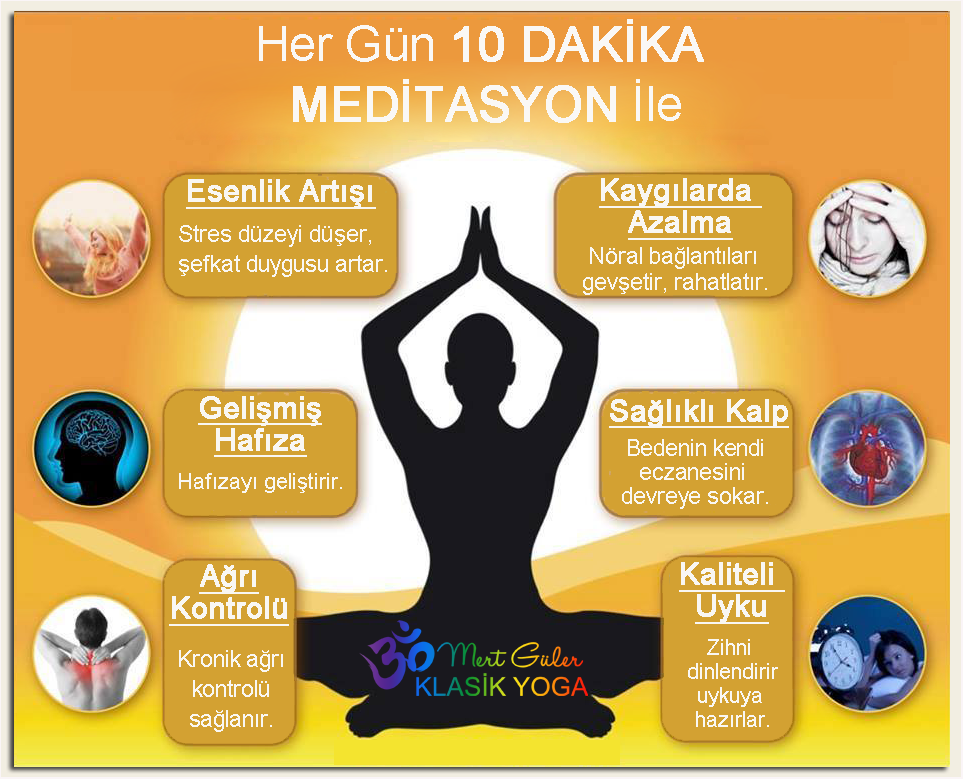 Fortunately, guided meditation is extremely helpful for improving sleep. In a recent systematic review and meta-analysis of controlled trials of the effects of mindfulness meditation (a form of guided meditation) on sleep, researchers found evidence that "mindfulness meditation interventions significantly improved sleep quality compared to non-specific active controls." nine0003
Fortunately, guided meditation is extremely helpful for improving sleep. In a recent systematic review and meta-analysis of controlled trials of the effects of mindfulness meditation (a form of guided meditation) on sleep, researchers found evidence that "mindfulness meditation interventions significantly improved sleep quality compared to non-specific active controls." nine0003
The specific ways in which meditation helps improve sleep range from the practice's ability to calm restless, anxious thoughts to its effect on deep breathing, an important element for better sleep.
This will help you let go of thoughts that cause anxiety and stress.
Anxiety is caused both by "phantom anxieties" and by real and practical life events. "Phantom anxiety" includes things like thinking about someone giving you an indecent look when it probably wasn't, or wondering if something uncertain in the future will go well. There is practically nothing you can do about these experiences or emotions. nine0003
nine0003
But real life anxieties are also real. For example, thinking about an upcoming medical test you're waiting for the results of can be truly daunting. Luckily, mindfulness meditation (focusing on the present moment) has been found to help reduce anxiety-producing thoughts, even real ones. A recent study by the Faculty of Health Sciences at the University of Southern Denmark proved this. The study involved random healthy subjects who underwent a certain number of mindfulness meditation trainings daily. The other group underwent control tests. nine0003
At the end of the study period, all participants underwent psychological experiments that examined their reactions to "conditioned fear responses". Those who completed the mindfulness meditation course were found to have significantly calmer arousal responses to conditioned fear responses. In essence, the results showed that meditation can help people forget about (and react to) their fears less.
Try Guided Meditation
Guided meditation should ideally be done in real time under the guidance of an instructor. However, if you're just getting started with meditation, you might be interested in trying out a trial meditation on your own. As a last resort, it is perfectly acceptable to record yourself reading a guided meditation text, so that you can then play it back and give yourself instructions during practice. nine0003
However, if you're just getting started with meditation, you might be interested in trying out a trial meditation on your own. As a last resort, it is perfectly acceptable to record yourself reading a guided meditation text, so that you can then play it back and give yourself instructions during practice. nine0003
In this regard, below is a short guided meditation for anxiety that you can try. Record yourself reading these words and listen to them as you wish to calm your fears, anxieties, worries, and any negative emotions.
When speaking the words of guided meditation, try to use a soft, slow, soothing voice. Leave small gaps of time between each section of the text.
[ Leave about 30 seconds at the beginning of the recording to allow yourself to move from the playback device to a position on the floor, in a chair, or on a cushion. ] nine0165
"Let's get started.
Sit in a comfortable position on the floor, on a cushion or in a chair.
Concentrate the spine as if from the base of the spine up to the crown of the head and towards the ceiling.
Gently close your eyes. Let your hands lie at your sides or on your knees. Pay attention to your body. Feel how your muscles become relaxed and free. Scan your body from head to toe, looking for places where you feel tension. Tighten these areas even more for a moment, and then release the tension as you exhale."
[Leave for one or two minutes to become fully aware of the body.]
"Now let's turn your attention to the breath. Begin with three full, deep breaths.
First exhale all the breath, trying to exhale even the air in the lowest part of the lungs. Now inhale deeply, expanding your lungs. Notice and feel your belly move outward as it fills with air. At the same time, your shoulders should not rise when you draw in air. Count to five: 1, 2, 3, 4, 5.
Hold the air in your lungs for a count of three: One, two, three.
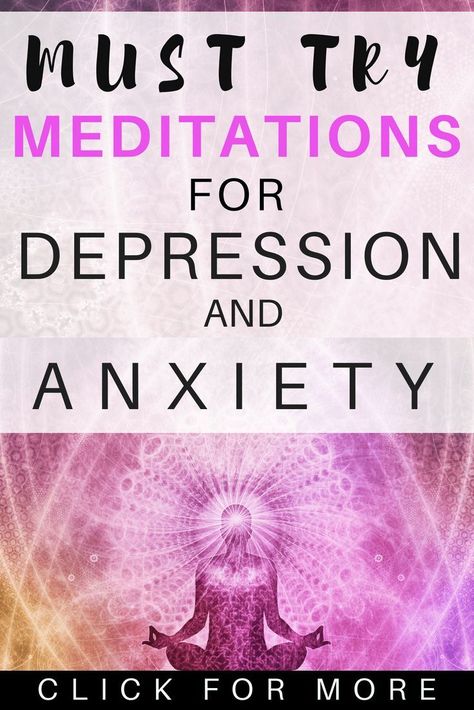
Now exhale the air, feeling the belly decrease in size as the air leaves the lungs and mouth. Exhale for a count of five: 1, 2, 3, 4, 5.
Repeat this process by inhaling: 1, 2, 3, 4, 5.
Hold the air: One, two, three.
And let the air out: One, two, three, four, five.
Do this one last time, inhaling: 1, 2, 3, 4, 5.
Hold the air: One, two, three.
And let go: One, two, three, four, five.
Continue to breathe normally as you feel comfortable.
Now let's do a little visualization.
Imagine that you are sitting on a beach. You are exactly where you are now, sitting on the sand of a beautiful ocean landscape and facing the water. There is no one around. The sun warms and pleasantly warms your skin, and you feel a cool breeze blowing on you in soft gusts. Behind you, the wind gently rustles the palms.
You hear the waves crashing on the sand of the beach. There are no other sounds. Enjoy a few minutes of relaxation here while still breathing normally. Just watch."
[Leave for two to three minutes].
"You are still on the beach, you hear the sound of the waves and the breeze, you feel the sun and the wind on your skin. Start concentrating on your breath. Take a deep breath, inhaling: 1, 2, 3, 4, 5.
Hold the air: One, two, three.
And let the air out: One, two, three, four, five.
And one more, inhaling: One, two, three, four, five.
nine0002 Hold the air: One, two, three.And let the air out: One, two, three, four, five.
And the last inhalation and exhalation, starting from the inhalation: 1, 2, 3, 4, 5.
Hold the air: One, two, three.
And let the air out: One, two, three, four, five.
Now smoothly return to normal breathing.
It's time to leave your warm spot on the beach. Watch the ocean waves and warm sand melt into your mind. Slowly open your eyes and look around."
Guided Anxiety Meditation: Frequently Asked Questions
Can meditation reduce anxiety?
Yes, although we are discussing guided meditation here, in principle any form of meditation can help relieve anxiety. In fact, this is one of the main reasons for starting the practice. In general, meditation will help you focus more on the present, increase self-awareness, reduce negative thoughts and emotions, and build a set of skills that will help you better deal with stress and anxiety in everyday life. nine0003
How to overcome anxiety during meditation?
Even though meditation is designed to combat anxiety and stress, it is ironic that meditation often causes anxiety. It doesn't happen to everyone, but if it has happened to you, here are a few things you can do.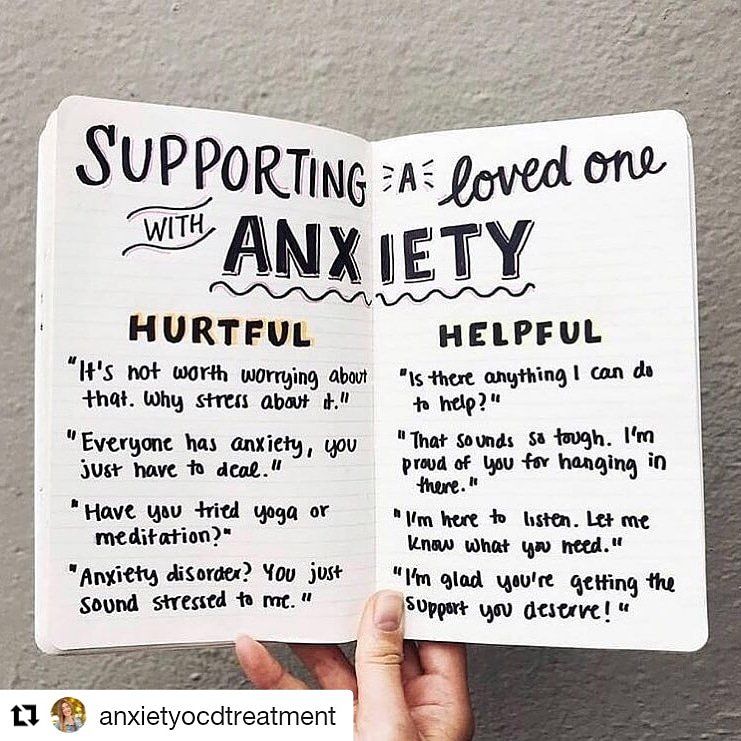
First of all, consider changing the guided meditations you listen to. If you are working with a meditation teacher, ask them if they have other guided meditations you can try. Some meditations are specifically designed to overcome anxiety. Second, remember that sometimes it's important to let go of the anxious thoughts and just keep practicing until the anxiety associated with meditation disappears. Most people will feel that this happens naturally if they continue the practice for some time. nine0003
Can meditation help with obsessive thoughts?
Yes, if you are looking for ways to deal with anxiety, meditation is one of the best ways to reduce intrusive thoughts - along with meditation and yoga. Today, more than ever, people are struggling with thinking too much. Moreover, intrusive thoughts often occur at night when you are trying to doze off, which inevitably causes a lot of additional problems.
Meditation helps with overthinking by helping to calm the mind and body and generally think more slowly.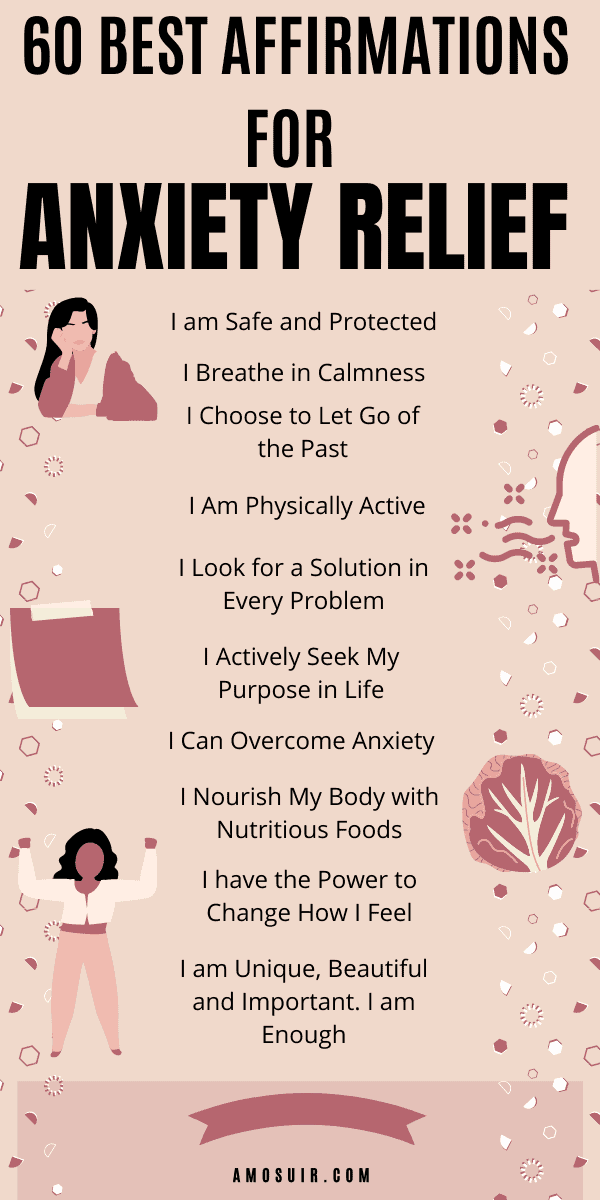 During meditation, you notice every thought, feeling, emotion, and many physical sensations. It's not something we do regularly, so slowing down in this way makes it less likely that you'll keep thinking in a fast paced and obsessive manner. nine0003
During meditation, you notice every thought, feeling, emotion, and many physical sensations. It's not something we do regularly, so slowing down in this way makes it less likely that you'll keep thinking in a fast paced and obsessive manner. nine0003
How long should I meditate for anxiety?
Ideally, meditation for anxiety should be practiced at least once a day for 10-20 minutes. But that might be where you need to get to. If you've never meditated before, start with just a few minutes a day. Even 3-5 minutes of daily meditation practice can make a big difference in your daily life in general and in dealing with anxiety in particular.
Can meditation help with panic attacks? nine0113
Yes. Panic attacks are often the result of fight-or-flight thinking, and meditation is the perfect solution to combat this extreme thought process that often causes excessive anxiety.
Those who suffer from panic disorder (frequent attacks and time spent in undue stress and worrying about the future or past) will find that meditation is the ideal remedy for dealing with anxiety in this way.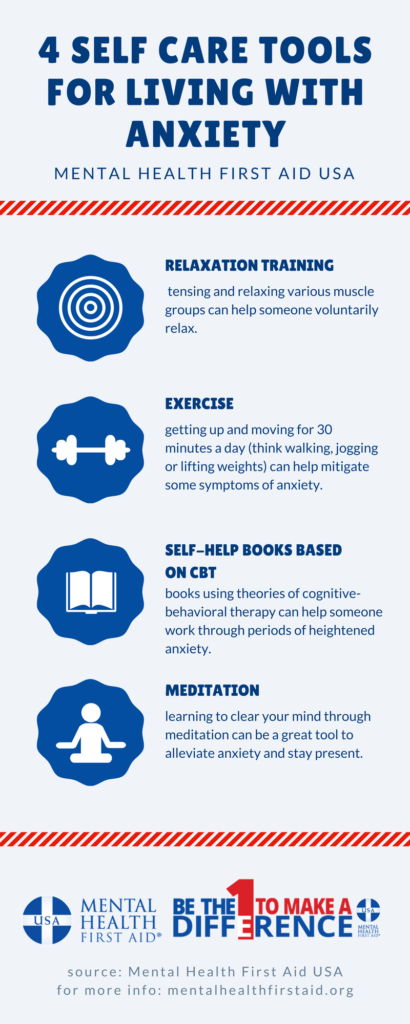
While you should always consult your doctor before starting any treatment plan, you can start meditation to relieve anxiety right now - on your own, in a group, or with a personal meditation teacher. It has virtually no negative side effects, and the results for people with panic disorder are amazing.
What are the best guided meditations for anxiety relief?
There are many variations of guided meditation. While it's always possible to record yourself reading a guided meditation and play it back when you're ready to meditate, it's best to get guidance from a teacher. nine0003
Your teacher will not only be a strong, soothing presence during your meditation session, but will be able to select guided meditation that best suits your state in life and on your path of meditation and healing.
How often should I use meditation to help manage anxiety?
You should use meditation to relieve anxiety as often as you need to. It is best to start with once a day for a few minutes.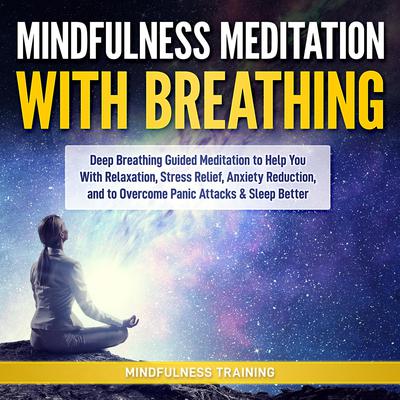 Try to pick a time of day when you have the least amount of things to do. Maybe early in the morning or right before bed. nine0003
Try to pick a time of day when you have the least amount of things to do. Maybe early in the morning or right before bed. nine0003
In the early days of your practice, it may be a good idea to vary the way you meditate. This will help you find the practice that works best for you. Try different types of meditation. For example, you can start with one-on-one practice with a teacher or with your own recorded voice. You can then move on to meditation in a small or large group. You may even find that this practice improves your life so much that you want to become a meditation and wellness teacher! nine0003
Should I sign up for meditation programs or courses?
Absolutely. A program, course, or online challenge can be helpful to support your practice and help you develop meditation skills and habits that you can apply to your daily life outside of the program. There are hundreds of options to choose from, ranging from mindfulness meditation to mindfulness-based stress reduction meditation, self-compassion meditation, or simple wellbeing meditation.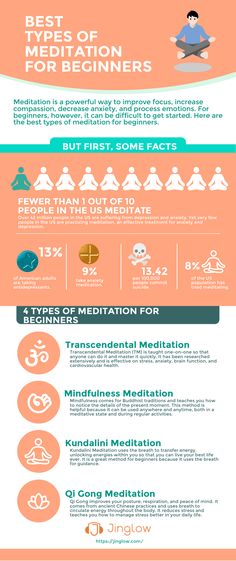 nine0003
nine0003
Resources for Anaachan Meditation
Meditation Vika
Meditation for chakras
Meditation techniques
Meditation of Body scan
Managed Meditation for children
City 9000 9000 9000
NIMH » Any Anxiety Disorder
Heart Disease Facts | cdc.gov
Research on Anxiety
Heart Rate Variability of Various Video-Aided Mindful Deep Breathing Durations and Its Impact on Depression, Anxiety, and Stress Symptom Severity | Springer Link
The effect of mindfulness meditation on sleep quality: a systematic review and meta‐analysis of randomized controlled trials - Rusch - 2019 - Annals of the New York Academy of Sciences
The effect of mindfulness training on extinction retention | Scientific Reports
Working with anxiety. 20 Minute Practice
Today I invite you to do one of the practices in the MBSR program, which allows you to deeply explore your feelings of anxiety and identify the triggers that trigger it.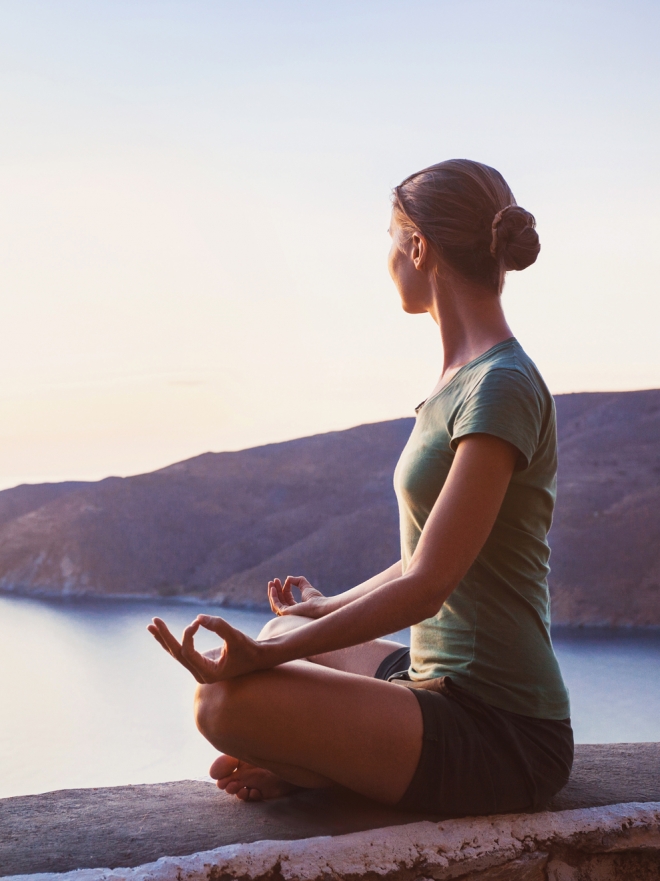 nine0003
nine0003
While anxiety sometimes seems to come out of nowhere, it usually has a source: most often, it's a combination of external conditions, personal history, memories, thoughts, and deeply buried emotions.
However, during meditation, do not try to force yourself to find this source and sort out its contents. The main goal of practice is to begin to explore yourself. Whatever you find inside, just being aware of it can make life so much easier. Instead of wasting energy on fighting anxiety, you can simply start changing your attitude towards this feeling. nine0003
Practice involves deliberately exploring feelings of anxiety, and this can be a difficult task. Before you start, think about whether you are ready, listen to the inner voice and make sure that the right moment is chosen. Start with a sense of security and interest when you have the strength and the mindset to study anxiety in depth. If now is not the right time, come back to practice later when you feel ready.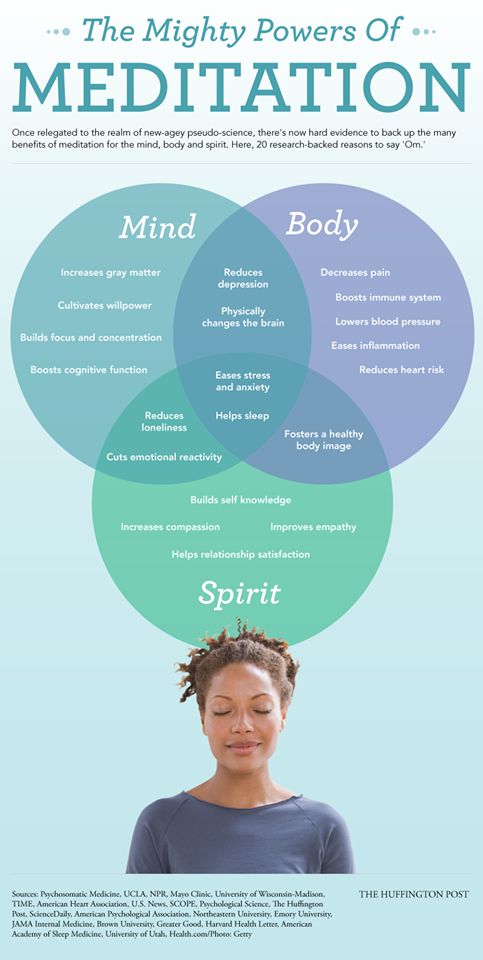
Read the entire text of the meditation first to familiarize yourself with it, and only then proceed with it, referring to the text as needed and pausing briefly after each paragraph. Allow about 20 minutes for the whole process. The practice can be done sitting, standing or even lying down. Take a position in which you will be both relaxed and focused. nine0003
Start with a short check of your current state: take a couple of minutes to understand how your body and mind are feeling right now - what exactly are your bodily sensations, what thoughts are in your head, what is the emotional background. There is no need to analyze and fix anything. Just accept your condition and let it be what it is. Fixate on the present.
Now gently shift your attention to your breath, feeling each inhalation and exhalation. Be aware of where it is felt most strongly - in the nose, chest, stomach, or maybe somewhere else. You don't have to rush anywhere… you don't have to do anything extra… just focus on your breath… inhale, exhale, and pause in between.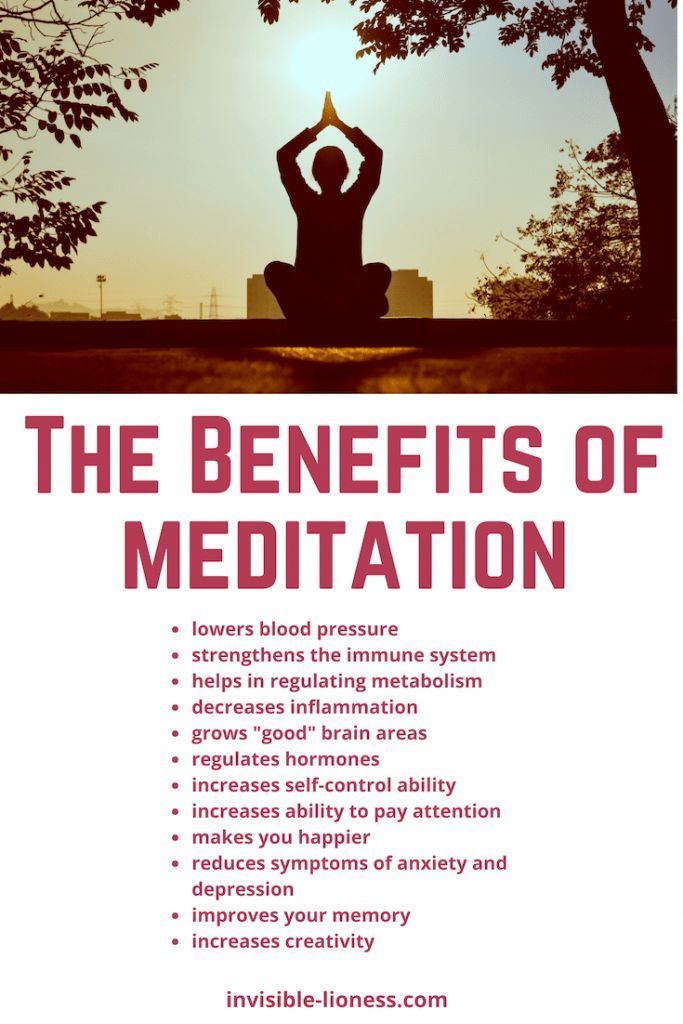 If attention slips, acknowledge that fact and then gently bring it back to the breath. nine0165
If attention slips, acknowledge that fact and then gently bring it back to the breath. nine0165
Now think of a specific, perhaps recent, situation in which you experienced anxiety and try to remember it again. No need to focus on some acute experience, let it be a state of 5-6 points on a scale from 1 to 10. Remember your experience as clearly as possible, awakening a wave of anxiety in the present moment, now.
As you visualize the experience and immerse yourself in it, notice how the anxiety is felt in the body and how it resides in it along with other sensations. Now your main task is to become aware of all your physical sensations and allow them to simply be. You don't have to try to change them. Let them come and go, like ripples on the water, which gradually merges with the surface of the lake. nine0165
Now notice the emotions that come up... anxiety, fear, sadness, anger, confusion... whatever. As with physical sensations, simply be aware of them, feel them in your body, and allow them to be. Do not try to analyze and correct them.
Do not try to analyze and correct them.
If strong emotions do not appear, this does not mean that the meditation was not performed correctly. The practice is to become aware of any of your current experiences, whatever their nature and strength, and let them simply exist. Whatever happens to you and your feelings during practice, that is practice. nine0165
Focusing on feelings of anxiety can sometimes make it worse. This is fine. The intensity of the feeling will subside as you open up to your experience, become aware of the experience, and give it space to exist.
Continue to experience anxiety, feeling it in your body and mind, allowing it to be, cultivating the strength of the spirit to accept things as they are. The very fact that you acknowledge your anxiety rather than hiding from it leads to healing. nine0165
Continuing to practice awareness of physical sensations and emotions can lead to the discovery of many deep memories, thoughts, feelings and physical experiences that once formed your limiting beliefs about yourself and the world around you.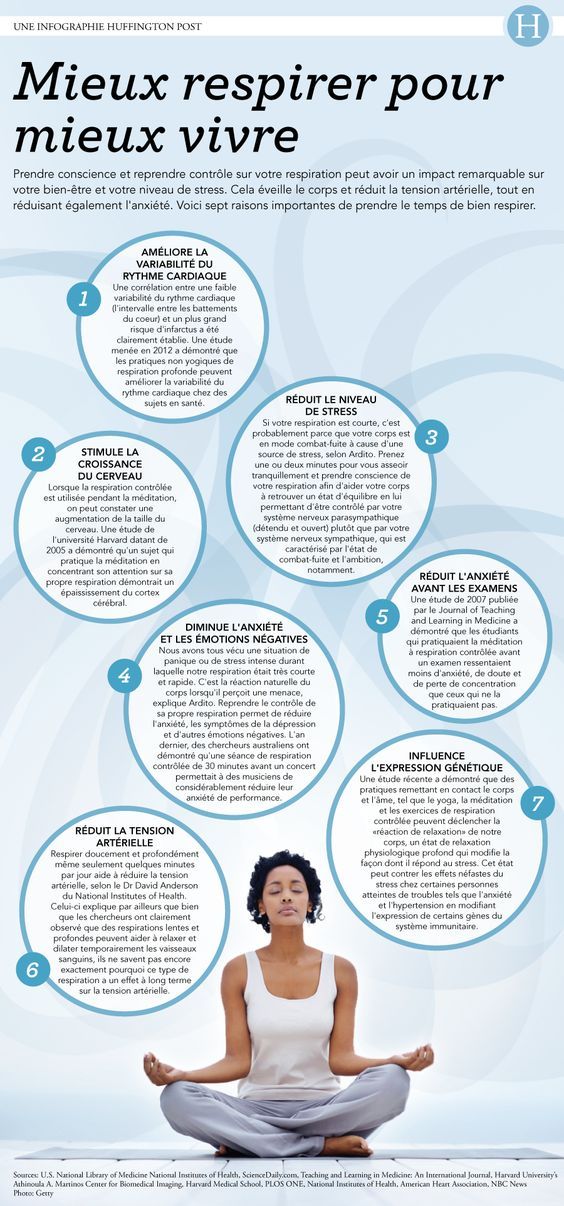 You may be able to see more clearly how these old patterns led you to anxiety. This understanding can set you free and you will feel freer than ever.
You may be able to see more clearly how these old patterns led you to anxiety. This understanding can set you free and you will feel freer than ever.
Now gradually shift your focus back to the breath, to conscious inhalations and exhalations… Then slowly switch from the breath to the sensations in the heart. Take some time to let self-compassion into your heart. Recognize your own courage in working with anxiety. As a result, your anxiety can turn from an enemy into a teacher, helping to open the heart to wisdom, compassion and lightness. nine0165
When you are ready to end your meditation, praise yourself for taking this time for yourself. Then open your eyes and gradually return to the surrounding reality.
Immediately after the end of the practice, try to fix the feelings from the experience. It's best to write them down. How did everything go? How did you deal with the bodily sensations, thoughts, and emotions that came up? How do you feel now?
Please enable JavaScript to view the comments powered by Disqus.
